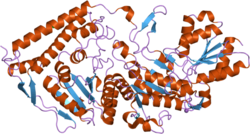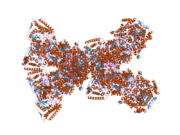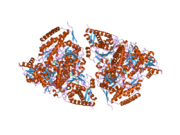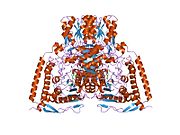| PDHB | |||||||||||||||||||||||||||||||||||||||||||||||||||
|---|---|---|---|---|---|---|---|---|---|---|---|---|---|---|---|---|---|---|---|---|---|---|---|---|---|---|---|---|---|---|---|---|---|---|---|---|---|---|---|---|---|---|---|---|---|---|---|---|---|---|---|
 | |||||||||||||||||||||||||||||||||||||||||||||||||||
| |||||||||||||||||||||||||||||||||||||||||||||||||||
| Identifiers | |||||||||||||||||||||||||||||||||||||||||||||||||||
| Aliases | PDHB, PDHBD, PDHE1-B, PHE1B, Pyruvate dehydrogenase (lipoamide) beta, PDHE1B, pyruvate dehydrogenase E1 beta subunit, pyruvate dehydrogenase E1 subunit beta | ||||||||||||||||||||||||||||||||||||||||||||||||||
| External IDs | OMIM: 179060; MGI: 1915513; HomoloGene: 712; GeneCards: PDHB; OMA:PDHB - orthologs | ||||||||||||||||||||||||||||||||||||||||||||||||||
| |||||||||||||||||||||||||||||||||||||||||||||||||||
| |||||||||||||||||||||||||||||||||||||||||||||||||||
| |||||||||||||||||||||||||||||||||||||||||||||||||||
| |||||||||||||||||||||||||||||||||||||||||||||||||||
| Wikidata | |||||||||||||||||||||||||||||||||||||||||||||||||||
| |||||||||||||||||||||||||||||||||||||||||||||||||||
Pyruvate dehydrogenase (lipoamide) beta, also known as pyruvate dehydrogenase E1 component subunit beta, mitochondrial or PDHE1-B is an enzyme that in humans is encoded by the PDHB gene. The pyruvate dehydrogenase (PDH) complex is a nuclear-encoded mitochondrial multienzyme complex that catalyzes the overall conversion of pyruvate to acetyl-CoA and CO2, and provides the primary link between glycolysis and the tricarboxylic acid (TCA) cycle. The PDH complex is composed of multiple copies of three enzymatic components: pyruvate dehydrogenase (E1), dihydrolipoamide acetyltransferase (E2) and lipoamide dehydrogenase (E3). The E1 enzyme is a heterotetramer of two alpha and two beta subunits. This gene encodes the E1 beta subunit. Mutations in this gene are associated with pyruvate dehydrogenase E1-beta deficiency.
Structure
The PDH genes that comprise the E1 subunit are 1.36 kilobases long (alpha) and 1.69 kb long (beta). The PDHB gene has a total of 10 exons and 9 introns. All intron-exon splice junctions follow the standard GT/AG rule. There was an Alu family found in introns 2 and 8. The 5' flanking region gene contains a "CAAT" consensus promoter sequence but no "TATA" sequence. The transcription start site is an adenine residue located 132 bases upstream from the initiation codon in exon 1. The mRNA species that results from transcription of PDHB has been experimentally determined, via Northern blotting, to be 1.6 kb in length, although another fragment 5.5 kb long was also identified.
The PDHB gene encodes a precursor protein that has 359 amino acid residues and a final mature protein that has 329 amino acids, and is part of the pyruvate dehydrogenase multienzyme complex. Two of the mature PDHB proteins come together with two PDHA proteins to form a heterotetrameric E1 subunit. Crystal Structures allowed for a model in which the enzyme undergoes a 2-A shuttle-like motion of its heterodimers to perform the catalysis. Specifically, the catalytic residue has been identified on the PDHB subunit, the 89th residue, which is a glutamate. In forming the entire PDH complex, the 289th beta residue, aspartic acid, interacts with the 276th residue of the E2 complex, a lysine. The entire human complex is 9.5 MDa in size, and has been described as 60-meric, meaning there are over 60 components that are assembled to make the entire complex. These subunits are conserved across many species, as the function of this complex is essential for the generation of ATP for all eukaryotes. Each component is responsible for the catalysis of one step in this pathway; this complex exists for the purpose of channeling the intermediates of each reaction to the next enzyme, thus greatly increasing the rate of reaction.
Function
The pyruvate dehydrogenase complex is responsible for the oxidative decarboxylation of pyruvate, with the final product being Acetyl CoA. Overall the complex catalyzes five reactions, with the overall reaction being:
Pyruvate + CoA + NAD → acetyl-CoA + CO2
There are three different coenzymes required throughout the 5 steps that this complex carries out: thiamine pyrophosphate (TPP), lipoamide, and coenzyme A. This step is only one of the central metabolic pathway carried out by eukaryotes, in which glucose is oxidized to form carbon dioxide, water, and ATP. The E1 complex specifically uses the TPP cofactor to cleave the Calpha-C(=O) bond of pyruvate, and then transfer the acetyl group to the TPP coenzyme, thus resulting in an intermediate, hydroxylethyl-Tpp*E1, and producing CO2. The thiazolium ring on the TPP is ideal for adding to carbonyl groups and acting as an electron sink, or a group that can pull electrons from a reaction and stabilize an electron-deficient intermediate. Additionally, PDHB interacts with Prolyl-hydroxylase PHD3 to regulate the cellular PDH activity.
Clinical significance
Mutations in the PDHB gene have been known to cause one form of pyruvate dehydrogenase deficiency. Pyruvate dehydrogenase deficiency is characterized by the buildup of a chemical called lactic acid in the body and a variety of neurological problems. Signs and symptoms of this condition usually first appear shortly after birth, and they can vary widely among affected individuals. The most common feature is a potentially life-threatening buildup of lactic acid (lactic acidosis), which can cause nausea, vomiting, severe breathing problems, and an abnormal heartbeat. People with pyruvate dehydrogenase deficiency usually have neurological problems as well. Most have delayed development of mental abilities and motor skills such as sitting and walking. Other neurological problems can include intellectual disability, seizures, weak muscle tone (hypotonia), poor coordination, and difficulty walking. Some affected individuals have abnormal brain structures, such as underdevelopment of the tissue connecting the left and right halves of the brain (corpus callosum), wasting away (atrophy) of the exterior part of the brain known as the cerebral cortex, or patches of damaged tissue (lesions) on some parts of the brain. Because of the severe health effects, many individuals with pyruvate dehydrogenase deficiency do not survive past childhood, although some may live into adolescence or adulthood. Most cases of pyruvate dehydrogenase complex (PDHc) deficiency are attributable to mutations in the PDHA1 gene which encodes the E(1)α subunit, with few cases of mutations in the genes for E3, E3BP, and E2 being described. However, there are a few cases in which mutations in the beta subunit gene have resulted in patients with Leigh syndrome. Many pathological mutations have been described, including: R36C, which results in conformational change due to increased amino acid interactions; C306R, overall affecting interaction of the two beta subunits; I142M, affecting conformation around a potassium ion, thereby reducing PDHB stability; W165S, which also affects hydrophobic interaction between the beta subunits; and Y132C. Other cases have been described in which there are no pathological mutations, but inborn errors of metabolism, specifically related to ubiquitination and proteasome machineries, resulted in a PDHB deficiency. This was demonstrated by PDH activity being restored in cells that were treated with MG132, which is known as proteasome inhibitor. The clinical manifestations of this deficiency are similar to those of PDHA1 deficiency, with the exception being that ataxia is less frequent in these cases, and that consanguinity was found only in families with the PDHB deficiency.
Interactive pathway map
Click on genes, proteins and metabolites below to link to respective articles.
[[File:

- The interactive pathway map can be edited at WikiPathways: "GlycolysisGluconeogenesis_WP534".
References
- ^ GRCh38: Ensembl release 89: ENSG00000168291 – Ensembl, May 2017
- ^ GRCm38: Ensembl release 89: ENSMUSG00000021748 – Ensembl, May 2017
- "Human PubMed Reference:". National Center for Biotechnology Information, U.S. National Library of Medicine.
- "Mouse PubMed Reference:". National Center for Biotechnology Information, U.S. National Library of Medicine.
- ^ "Entrez Gene: pyruvate dehydrogenase (lipoamide) beta".
- Koike K, Urata Y, Koike M (Aug 1990). "Molecular cloning and characterization of human pyruvate dehydrogenase beta subunit gene". Proceedings of the National Academy of Sciences of the United States of America. 87 (15): 5594–7. Bibcode:1990PNAS...87.5594K. doi:10.1073/pnas.87.15.5594. PMC 54373. PMID 2377599.
- ^ Koike K, Ohta S, Urata Y, Kagawa Y, Koike M (Jan 1988). "Cloning and sequencing of cDNAs encoding alpha and beta subunits of human pyruvate dehydrogenase". Proceedings of the National Academy of Sciences of the United States of America. 85 (1): 41–5. Bibcode:1988PNAS...85...41K. doi:10.1073/pnas.85.1.41. PMC 279477. PMID 3422424.
- Koike K, Urata Y, Koike M (Aug 1990). "Molecular cloning and characterization of human pyruvate dehydrogenase beta subunit gene". Proceedings of the National Academy of Sciences of the United States of America. 87 (15): 5594–7. Bibcode:1990PNAS...87.5594K. doi:10.1073/pnas.87.15.5594. PMC 54373. PMID 2377599.
- Chun K, Mackay N, Willard HF, Robinson BH (Dec 1990). "Isolation, characterization and chromosomal localization of cDNA clones for the E1 beta subunit of the pyruvate dehydrogenase complex". European Journal of Biochemistry. 194 (2): 587–92. doi:10.1111/j.1432-1033.1990.tb15656.x. PMID 1702713.
- Ciszak EM, Korotchkina LG, Dominiak PM, Sidhu S, Patel MS (Jun 2003). "Structural basis for flip-flop action of thiamin pyrophosphate-dependent enzymes revealed by human pyruvate dehydrogenase". The Journal of Biological Chemistry. 278 (23): 21240–6. doi:10.1074/jbc.M300339200. hdl:2060/20030106063. PMID 12651851.
- Fang R, Nixon PF, Duggleby RG (Oct 1998). "Identification of the catalytic glutamate in the E1 component of human pyruvate dehydrogenase". FEBS Letters. 437 (3): 273–7. Bibcode:1998FEBSL.437..273F. doi:10.1016/s0014-5793(98)01249-6. PMID 9824306. S2CID 40849431.
- Korotchkina LG, Patel MS (Feb 2008). "Binding of pyruvate dehydrogenase to the core of the human pyruvate dehydrogenase complex". FEBS Letters. 582 (3): 468–72. Bibcode:2008FEBSL.582..468K. doi:10.1016/j.febslet.2007.12.041. PMC 2262399. PMID 18206651.
- Hiromasa Y, Fujisawa T, Aso Y, Roche TE (Feb 2004). "Organization of the cores of the mammalian pyruvate dehydrogenase complex formed by E2 and E2 plus the E3-binding protein and their capacities to bind the E1 and E3 components". The Journal of Biological Chemistry. 279 (8): 6921–33. doi:10.1074/jbc.M308172200. PMID 14638692.
- ^ Voet DJ, Voet JG, Pratt CW (2010). "Chapter 17, Citric Acid Cycle". Principles of Biochemistry (4th ed.). Wiley. p. 550. ISBN 978-0-470-23396-2.
- Kikuchi D, Minamishima YA, Nakayama K (Aug 2014). "Prolyl-hydroxylase PHD3 interacts with pyruvate dehydrogenase (PDH)-E1β and regulates the cellular PDH activity". Biochemical and Biophysical Research Communications. 451 (2): 288–94. doi:10.1016/j.bbrc.2014.07.114. PMID 25088999.
- Quintana E, Mayr JA, García Silva MT, Font A, Tortoledo MA, Moliner S, Ozaez L, Lluch M, Cabello A, Ricoy JR, Koch J, Ribes A, Sperl W, Briones P (Dec 2009). "PDH E1β deficiency with novel mutations in two patients with Leigh syndrome". Journal of Inherited Metabolic Disease. 32 (Suppl 1): S339–43. doi:10.1007/s10545-009-1343-1. PMID 19924563. S2CID 24240088.
- ^ Okajima K, Korotchkina LG, Prasad C, Rupar T, Phillips JA, Ficicioglu C, Hertecant J, Patel MS, Kerr DS (Apr 2008). "Mutations of the E1beta subunit gene (PDHB) in four families with pyruvate dehydrogenase deficiency". Molecular Genetics and Metabolism. 93 (4): 371–80. doi:10.1016/j.ymgme.2007.10.135. PMID 18164639.
- Han Z, Zhong L, Srivastava A, Stacpoole PW (Jan 2008). "Pyruvate dehydrogenase complex deficiency caused by ubiquitination and proteasome-mediated degradation of the E1 subunit". The Journal of Biological Chemistry. 283 (1): 237–43. doi:10.1074/jbc.M704748200. PMID 17923481.
Further reading
- Ciszak EM, Korotchkina LG, Dominiak PM, Sidhu S, Patel MS (Jun 2003). "Structural basis for flip-flop action of thiamin pyrophosphate-dependent enzymes revealed by human pyruvate dehydrogenase". The Journal of Biological Chemistry. 278 (23): 21240–6. doi:10.1074/jbc.M300339200. hdl:2060/20030106063. PMID 12651851.
- Okajima K, Korotchkina LG, Prasad C, Rupar T, Phillips JA, Ficicioglu C, Hertecant J, Patel MS, Kerr DS (Apr 2008). "Mutations of the E1beta subunit gene (PDHB) in four families with pyruvate dehydrogenase deficiency". Molecular Genetics and Metabolism. 93 (4): 371–80. doi:10.1016/j.ymgme.2007.10.135. PMID 18164639.
- Kimura K, Wakamatsu A, Suzuki Y, Ota T, Nishikawa T, Yamashita R, Yamamoto J, Sekine M, Tsuritani K, Wakaguri H, Ishii S, Sugiyama T, Saito K, Isono Y, Irie R, Kushida N, Yoneyama T, Otsuka R, Kanda K, Yokoi T, Kondo H, Wagatsuma M, Murakawa K, Ishida S, Ishibashi T, Takahashi-Fujii A, Tanase T, Nagai K, Kikuchi H, Nakai K, Isogai T, Sugano S (Jan 2006). "Diversification of transcriptional modulation: large-scale identification and characterization of putative alternative promoters of human genes". Genome Research. 16 (1): 55–65. doi:10.1101/gr.4039406. PMC 1356129. PMID 16344560.
- Wiemann S, Weil B, Wellenreuther R, Gassenhuber J, Glassl S, Ansorge W, Böcher M, Blöcker H, Bauersachs S, Blum H, Lauber J, Düsterhöft A, Beyer A, Köhrer K, Strack N, Mewes HW, Ottenwälder B, Obermaier B, Tampe J, Heubner D, Wambutt R, Korn B, Klein M, Poustka A (Mar 2001). "Toward a catalog of human genes and proteins: sequencing and analysis of 500 novel complete protein coding human cDNAs". Genome Research. 11 (3): 422–35. doi:10.1101/gr.GR1547R. PMC 311072. PMID 11230166.
- Brown RM, Head RA, Boubriak II, Leonard JV, Thomas NH, Brown GK (Jul 2004). "Mutations in the gene for the E1beta subunit: a novel cause of pyruvate dehydrogenase deficiency". Human Genetics. 115 (2): 123–7. doi:10.1007/s00439-004-1124-8. PMID 15138885. S2CID 30741075.
- Sugden MC, Holness MJ (May 2003). "Recent advances in mechanisms regulating glucose oxidation at the level of the pyruvate dehydrogenase complex by PDKs". American Journal of Physiology. Endocrinology and Metabolism. 284 (5): E855–62. doi:10.1152/ajpendo.00526.2002. PMID 12676647.
- Suzuki Y, Yoshitomo-Nakagawa K, Maruyama K, Suyama A, Sugano S (Oct 1997). "Construction and characterization of a full length-enriched and a 5'-end-enriched cDNA library". Gene. 200 (1–2): 149–56. doi:10.1016/S0378-1119(97)00411-3. PMID 9373149.
- Korotchkina LG, Patel MS (Feb 2008). "Binding of pyruvate dehydrogenase to the core of the human pyruvate dehydrogenase complex". FEBS Letters. 582 (3): 468–72. Bibcode:2008FEBSL.582..468K. doi:10.1016/j.febslet.2007.12.041. PMC 2262399. PMID 18206651.
- Fang R, Nixon PF, Duggleby RG (Oct 1998). "Identification of the catalytic glutamate in the E1 component of human pyruvate dehydrogenase". FEBS Letters. 437 (3): 273–7. Bibcode:1998FEBSL.437..273F. doi:10.1016/S0014-5793(98)01249-6. PMID 9824306. S2CID 40849431.
- Han Z, Zhong L, Srivastava A, Stacpoole PW (Jan 2008). "Pyruvate dehydrogenase complex deficiency caused by ubiquitination and proteasome-mediated degradation of the E1 subunit". The Journal of Biological Chemistry. 283 (1): 237–43. doi:10.1074/jbc.M704748200. PMID 17923481.
- Caruso M, Maitan MA, Bifulco G, Miele C, Vigliotta G, Oriente F, Formisano P, Beguinot F (Nov 2001). "Activation and mitochondrial translocation of protein kinase Cdelta are necessary for insulin stimulation of pyruvate dehydrogenase complex activity in muscle and liver cells". The Journal of Biological Chemistry. 276 (48): 45088–97. doi:10.1074/jbc.M105451200. PMID 11577086.
- Hirner S, Krohne C, Schuster A, Hoffmann S, Witt S, Erber R, Sticht C, Gasch A, Labeit S, Labeit D (Jun 2008). "MuRF1-dependent regulation of systemic carbohydrate metabolism as revealed from transgenic mouse studies". Journal of Molecular Biology. 379 (4): 666–77. doi:10.1016/j.jmb.2008.03.049. PMID 18468620.
- Mehrle A, Rosenfelder H, Schupp I, del Val C, Arlt D, Hahne F, Bechtel S, Simpson J, Hofmann O, Hide W, Glatting KH, Huber W, Pepperkok R, Poustka A, Wiemann S (Jan 2006). "The LIFEdb database in 2006". Nucleic Acids Research. 34 (Database issue): D415–8. doi:10.1093/nar/gkj139. PMC 1347501. PMID 16381901.
- Hiromasa Y, Fujisawa T, Aso Y, Roche TE (Feb 2004). "Organization of the cores of the mammalian pyruvate dehydrogenase complex formed by E2 and E2 plus the E3-binding protein and their capacities to bind the E1 and E3 components". The Journal of Biological Chemistry. 279 (8): 6921–33. doi:10.1074/jbc.M308172200. PMID 14638692.
- Hartley JL, Temple GF, Brasch MA (Nov 2000). "DNA cloning using in vitro site-specific recombination". Genome Research. 10 (11): 1788–95. doi:10.1101/gr.143000. PMC 310948. PMID 11076863.
- Bonaldo MF, Lennon G, Soares MB (Sep 1996). "Normalization and subtraction: two approaches to facilitate gene discovery". Genome Research. 6 (9): 791–806. doi:10.1101/gr.6.9.791. PMID 8889548.
- Maruyama K, Sugano S (Jan 1994). "Oligo-capping: a simple method to replace the cap structure of eukaryotic mRNAs with oligoribonucleotides". Gene. 138 (1–2): 171–4. doi:10.1016/0378-1119(94)90802-8. PMID 8125298.
- Wiemann S, Arlt D, Huber W, Wellenreuther R, Schleeger S, Mehrle A, Bechtel S, Sauermann M, Korf U, Pepperkok R, Sültmann H, Poustka A (Oct 2004). "From ORFeome to biology: a functional genomics pipeline". Genome Research. 14 (10B): 2136–44. doi:10.1101/gr.2576704. PMC 528930. PMID 15489336.
This article incorporates text from the United States National Library of Medicine, which is in the public domain.
| Aldehyde/oxo oxidoreductases (EC 1.2) | |
|---|---|
| 1.2.1: NAD or NADP | |
| 1.2.2: cytochrome | |
| 1.2.3: oxygen | |
| 1.2.4: disulfide | |
| 1.2.7: iron–sulfur protein | |
| Enzymes | |
|---|---|
| Activity | |
| Regulation | |
| Classification | |
| Kinetics | |
| Types |
|










